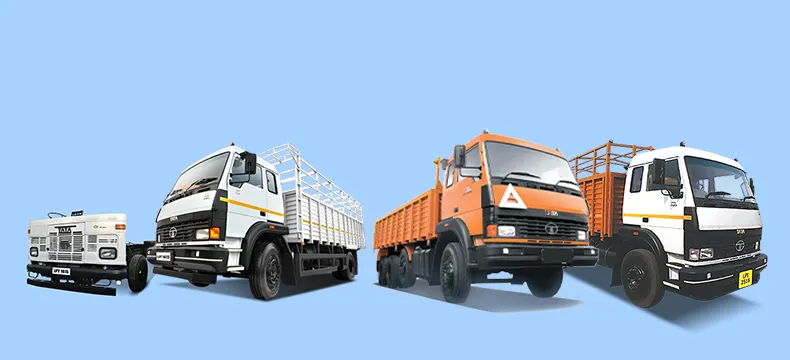17 Sep 2025

Top Heavy Commercial Vehicles for 2025: A Comprehensive List
- Tata Motors
- 7 Feb 2025
- COMMERCIAL VEHICLE
Introduction
Several sectors like manufacturing, industries, infrastructure, agriculture depend on heavy commercial vehicles for their smooth function, which turns contributing to the seamless functioning of the supply-demand chain of the entire country. Nepal is no exception. Heavy commercial vehicles (HCVs) are the backbone of Nepalese industries that rely on the efficient transportation of goods and materials.
2025 has several heavy commercial vehicles with advanced technologies that provide high performance, reliability, durability, and optimised profits for businesses. Tata Motors HCV lead the pack in the commercial trucks globally, providing sturdy, robust trucks that are compatible with all-weather conditions, diverse terrains, and geographies, offering world-class logistic solutions.
In this article, let us delve into technical and other key features of Tata Motors heavy commercial vehicles like Tata LPT 1613, Tata LPT 1615, Tata LPT 3118, and Tata LPT 2518.
Key Considerations When Choosing a Heavy-Duty Truck
Let us see some significant factors to consider while selecting a heavy-duty commercial vehicle:
-
Engine and Torque
– The engine is the heart of the truck; it determines the performance, durability, and fuel efficiency of the overall performance of the truck in the long term. The torque of the vehicle determines its ability to handle diverse terrains. -
Payload Capacity and Tonnage
– Heavy-duty trucks should include optimised payload capacity and adequate tonnage to handle freight while giving good performance. -
Chassis Type
– The chassis of the commercial heavy vehicles must be sturdy and robust to handle heavy payloads while providing stability and durability. -
Braking System
– Technologically advanced braking systems like air brakes or ABS (anti-lock braking system) for enhanced stability and safety. -
Steering and Ground Clearance
– Power steering helps the driver navigate challenging terrains more efficiently, and adequate ground clearance ensures driving on uneven terrains does not cause damage to the underbelly of the truck. -
Cabin Comfort
– A comfortable, ergonomic cabin minimises driver fatigue on long journeys, especially during challenging terrains like the mountainous roads in Nepal.
Top Heavy Trucks for Commercial Use 2025: A Complete List
Here is an advanced heavy-duty truck list from Tata Motors in 2025 that are ideal for use in Nepal.
1. Tata LPT 1615
- Engine: Cummins 6BT155 5.931 Water-cooled, Turbocharged, Diesel Engine.
- Torque: 605Nm at 1500 rpm
- Payload Capacity: 11135 kg
- Tonnage: 16 tonnes
- Chassis Type: Ladder frame with high-strength steel chassis frame.
- Brakes: Dual circuit full air S-Cam brake
- Steering: Hydraulic assisted power steering.
- Cabin: Ergonomic day cabin with tilt function, Non-AC
- Ground Clearance: 435 mm
The Tata LPT 1615 is a high-performing HCV with massive payload capacity, fuel efficiency, and sturdy design, providing smooth and seamless transport experience for long-haul, heavy cargo operations in all terrains and weather conditions.
2. Tata LPT 1613
- Engine: Cummins 6BT 155 5.9 31 Water-cooled, Turbocharged, 5883 CC Diesel Engine
- Torque: 450 Nm @ 1200-1800 rpm
- Payload Capacity: 11577 kg
- Tonnage: 16 tonnes
- Chassis Type: Reinforced ladder frame with bolted steel frame
- Brakes: Full air S-Cam brakes
- Steering: Integral hydraulic power-assisted
- Cabin: Spacious day cabin with improved ventilation, Non-AC
- Ground Clearance: 220 mm
The Tata LPT 1613 is a compact heavy commercial vehicle with high payload capacity and superior fuel efficiency, ideal for urban deliveries and short intercity freight movement.
3. Tata LPT 2518
- Engine: Cummins B5.9 Water cooled direct injection; turbo charged intercooled 5883 CC Diesel Engine with viscous fan.
- Torque: 850 Nm @ 1400-1800 rpm
- Payload Capacity: 12,000 kg
- Tonnage: 25 tonnes
- Chassis Type: Heavy-duty reinforced steel ladder frame for maximum load stability
- Brakes: Service Brakes - Dual circuit Full Air S-cam. Auxiliary Brake - Engine exhaust brake
- Steering: Hydraulic power-assisted steering.
- Cabin: Ergonomic sleeper cabin for enhanced comfort during long hauls. AC/ non-AC
- Ground Clearance: 260 mm
The Tata LPT 2518 is designed for heavy-duty loads used in industries like mining and construction that require sturdy, reliable commercial vehicles.
4. Tata LPT 3118
- Engine: Cummins B5.9-180 -32, water-cooled turbocharged diesel engine
- Engine Capacity: 5883 CC
- Engine Power: 180 HP @ 2500 rpm
- Torque: 680 Nm @ 1400 rpm
- Clutch: 380 mm
- Steering System: Hydraulic power steering
- Brakes: Full air S-Cam with automatic adjuster
- GVW: 31,000 kg
- Fuel Tank Capacity: 400 litres
The Tata LPT 3118 is a reliable heavy-duty tipper designed for demanding construction and mining operations. With exceptional gradeability, robust suspension, and high GVW, it delivers outstanding performance on challenging terrains. Its spacious design and advanced braking system ensure safety and comfort for drivers during long hauls.
Advanced Heavy-Duty Trucks for 2025: Leading the Way
There are several top-heavy trucks for commercial use with advanced technology from Tata Motors that offer efficient and effective cargo movement in 2025. For instance, the Tata LPT 2518 is a heavy-duty truck equipped with a powerful Cummins diesel engine, sophisticated braking systems, and high-grade suspension, making it an ideal choice for rugged terrains. The Tata LPT 1615 and Tata LPT 1613 are HCVs that are durable, capable, and versatile due to their compact build for urban and long-distance freight transport.
Top Heavy Trucks for Commercial Use in Various Industries
Let us see some key industries Tata Motors HCVs can be used in:
-
Logistics and Distribution
Logistics and cargo movement require trucks with high-capacity payloads, powerful engines, fuel efficiency, and sturdiness, such as the Tata LPT 2516.
-
Urban Freight
Urban cargo delivery requires HCVs that are compact yet spacious and can handle large deliveries in urban areas, like the Tata LPT 1613.
-
Construction and Mining
The Tata LPT 1615 and LPT 2516 can handle rugged terrains like mining and construction sites while carrying heavy loads. These HCVs deliver high performance in several sectors due to their versatility and strength.
Conclusion
Tata Motors Nepal offers several high-performance advanced heavy-duty trucks in 2025 that are ideal for several sectors like manufacturing, construction, mining, and heavy infrastructure development. Visit their website for more details on their heavy-duty truck list.
FAQ
-
What should I look for when selecting a heavy-duty truck?
Vital factors to look for include engine efficiency, payload capacity, torque, chassis, good mileage, and sophisticated braking and suspension systems. Ensure the heavy commercial vehicle is sturdy, safe, and operational.
-
What advancements can we expect in heavy commercial vehicles for 2025?
Technological advancements like anti-lock braking systems, ergonomic cabins, terrain compatibility, and optimized powerful engines can be expected in commercial vehicles from 2025.
-
What industries benefit the most from heavy commercial vehicles?
Industries such as mining, construction, logistics, and manufacturing companies that require the movement of large cargo loads can benefit from heavy commercial vehicles.
-
How do advanced heavy-duty trucks improve operational efficiency?
Advanced trucks have fuel-efficient engines, improved load-bearing capacity, and enhanced safety features, leading to reduced maintenance and operational costs.
-
Why is fuel efficiency important when selecting a heavy-duty truck?
Fuel efficiency lowers operational costs, especially for businesses involved in long-distance transportation. Over time, it helps improve profit margins by reducing fuel expenses.
- Tags
Latest Blogs


10 Sep 2025
What Exactly Is Torque in A Truck Engine?

10 Sep 2025


















